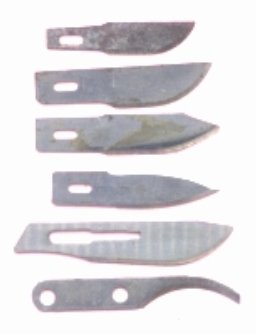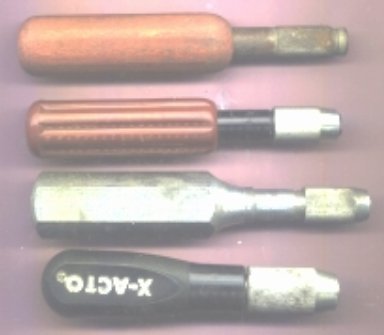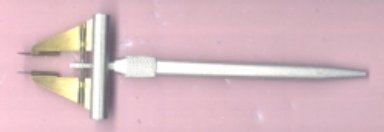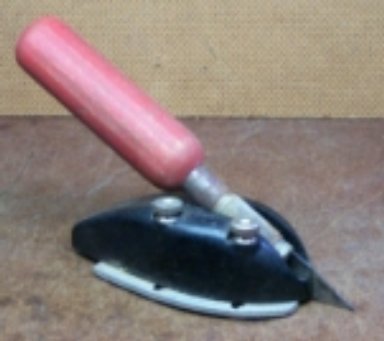These are probably among the first simple, flint flake tools developed. But today they have spread out to an extremely wide variety of forms, shapes, sizes and purposes. In the hobby field, their range may cause confusion in selection. In addition many very useful ones are found in other fields. To make wise choices, their uses and misuses should be understood. In many cases other tools may accomplish functions better. Although they may be separable. in most cases the two main parts, the blade and the handle, are joined in an unholy wedlock. The blade mist be very sharp to cut properly and the handle must be comfortable when manipulating blade during cutting plus hold blade very securely.
INTERCHANGEABLE BLADE
Probably the most common are the Xacto or Xpo type knives with interchangeable blades and handles. The selection of combinations is overwhelming, when scanning catalogs of various sources. To add to the confusion, each is supposed to be better than the rest. Final selection will be determined by the jobs at hand and personal choice. However it is wise to have a fair selection on hand to meet varying requirements.
Straight single edged blades come in a variety of sizes and forms. The most common and useful of which is the #11 and its minor variations, such as stainless steel. I buy these in bulk packs of 100 for economy and have found no great advantage to stainless steel to warrant the extra cost. Using color coded handles, new blades are used on plastic and wood then passed to the other handle for removing metal flash and other work. The latter are frequently re-sharpened . Length, angle and weight of cut may indicate other choices.
For some comparison of sizes and types of blades.

Note: Adjust brightness and contrast for optimum viewing.
STRAIGHT BLADES.
Swivel frisket.
#4b Stencil.
#11
#24
Sears utility
#8 double ended
Lewis Guarded Safety
Some have their cutting edges at the end for chiselling type cuts.

Note: Adjust brightness and contrast for optimum viewing.
END BLADES
#16 chisel or tight space cutter.
#17
#18
Curved blades can be used help create concave or convex surfaces.

Note: Adjust brightness and contrast for optimum viewing.
CURVED EDGE BLADES
#10
#22
#25
#23X
Large scalpel.
#104 carving.
Specialty blades may be used, if needed. In addition to those below, some are listed under CHISELS or PUNCHES .
Designed to cut slots for hinges in model airplanes , different sized forks are pushed in to set and cut the width and depth, then the hooked blade is used to dig out the material between cuts.

Note: Adjust brightness and contrast for optimum viewing.
HINGE SLOT CUTTER
FORK
HOOK
Special carving blades may be of use in more rare cases.
HANDLES
The prime requisites of any tool handle are that the working section of the tool be held securely and in the correct position. If the cutting edge of a blade can not be positioned correctly on the work, cutting may be done only with extreme difficulty. Next the heft and bulk should be commensurate with the force required. An axe handle would be useless for a surgeon using a scalpel blade. The shape should fit the grip required to permit manipulation during work. Finger indentations have no place on handles used with a #11 blade. In some cases shape may reveal the orientation of the cutting edge to advantage. Balance should not interfere with the feel of the cutting edge on the work. Weight at the blade end tends to deepen cut, while at the opposite end the opposite is true. Experience will soon prove that feel is very important in all delicate work.
Over the years handle designs and materials have changed, not always for the better. It appears the new gimmick from the MBA boys in marketing is that they have determined that all modelers have soft fingers that must be protected from those harsh round metal handles and they do not have the strength to hold the handle without slipping, Thus we have the influx of thicker rubber coated handles with reduced feel for the cut. Their second premise is that we all need protection from mounted blades during storage and that the added bulk of security devices are not an inconvenience or do not destroy the feel.
Having almost all the undesirable features excluding the rubber coating, a classic example of ruining a handle is this Xacto super safe one, with a sliding sleeve. There is a very uncomfortable step between the ferrule and the too thick sleeve. The sleeve and hexagonal anti-roll throw the center of mass away from the cutting end, tending to lift it and destroy the feel. Loosening and tightening the ferrule plus sliding the shield back and forth gets to be a pain.

Note: Adjust brightness and contrast for optimum viewing.
XACTO #1 SAFETY HANDLE WITH SLIDING SLEEVE SHIELD,
Over the years material has changed along with the collet from 1 to 2 slits on some. My first plastic #1 broke during normal use, The ferrules on #1 aluminum had a tendency to loosen and if stored extensively with a blade intact, it would oxidize and stick. Being far less expensive, The newer one are useful for holding blade that are not changed frequently. The Gripster is the most convenient for quick changes of dulled #11 blades. The #2 accept all larger flat tanged blades;

Note: Adjust brightness and contrast for optimum viewing.
SMALLER HANDLES
Stencil
Swivel
#1
Plastic #1 with semi-permanent gluing pin.
Gripster
#2
For more heft larger handles are useful and have a centered holes in the collet to hold gouges, routers and razor saws. The most comfortable, is the carving handle.

Note: Adjust brightness and contrast for optimum viewing.
LARGER HANDLES
Old wooden #5, no center hole.
Newer plastic #5
Aluminum #6
Plastic woodcarving
Other types usually hold specific blades.
Light weight utility knives are handy around the layout for heavier cutting. Variation and sizes are quite broad, but most are too large. A few of the common ones are shown. Some have snap off blades to renew end. Most have blade exposure adjustments.

Note: Adjust brightness and contrast for optimum viewing.
SMALLER UTILITY KNIVES
Old Xacto #8, metal. No adjustment.
Newer Xacto #8, plastic.
Olfa with blade snapper.
Xacto
If you ever tried Al Westerfield's excellent suggestion to trim and cut parts in his resin kits using a single edge razor blade, you probably got sore, indented fingers. These handles can help. In the top one, the angle is not enough to permit convenient slicing. It can accept double edged blades if you can find them. Although the single edge handle is a little bulky, it still permits a good feel for the work.

Note: Adjust brightness and contrast for optimum viewing.
RAZOR BLADE HANDLES
Double edge type with original blade.
Single edge.
SPECIAL CUTTERS
The best way to cut plastic sheets is to scribe them and then snap at the line. The best tool found for scribing is the Olfa P-cutter with its hook point and arc deburrer. With one or more passes a groove, deep enough to permit snapping, is scribed using a metal straight edge guide. After snapping the arc in the hook can scrape away burrs.

Note: Adjust brightness and contrast for optimum viewing.
OLFA P-CUTTER
Hook scribes sheet using bar on Dupli-Cutter as guide.
Arc deburrs edges after snapping.
Extra blades store in handle.
The best holder and aligner is the NWSL Dupli-Cutter with a sheet stop that slides between runners and is held in place by clamps on the runners. Spring opening clamp bar holds work sheet for snapping and serves as scribing guide. For angle cuts, suitable triangular shapes may be placed between stop and work sheet.

Note: Adjust brightness and contrast for optimum viewing.
DUPLI-CUTTER
For parallel cuts at varying distances, this adjustable handle simplifies the job.

Note: Adjust brightness and contrast for optimum viewing.
PARALLEL CUT HANDLE
For very delicate work, scalpels are thin, extremely sharp and come in small sizes. Since they are used by surgeons quality is excellent. Handles vary, as do blade shapes.

Note: Adjust brightness and contrast for optimum viewing.
SCALPEL
Smaller and finer than stencil knife.
Plastic handle, One time use.
Metal handle with unique slide on blade holder for slot in shank.
GUIDES
Any metal or formed template can serve as a guide when cutting single or multiple parts.
To help cut circles and arcs with reasonable accuracy, compasses and trammels can use an established center. The minimum radius is about 2" with only minor difficulty. Using a swivel knife. the max for the compass is about 12" and using a spear tipped blade and a swivel top handle, the trammel is about 16". However grater radii can be attained by using a longer piece of 1/4" square bar stock. The trammel did a very good job, cutting asphalt roof shingles, while installing a vent. Almost any good, sturdy compass, that can clamp a knife handle, will serve the purpose.

Note: Adjust brightness and contrast for optimum viewing.
COMPASS

Note: Adjust brightness and contrast for optimum viewing.
XACTO TRAMMEL
with extension bar.
Repeatedly cutting strips of material to simulate lumber or structural elements can be tricky and tedious. Borrowing from the model airplane buffs, strips can be cut with their adjustable balsa strippers. Blade distance from guide is set to width of strip. Guide is then slid along edge of sheet stock, cutting away strip.

Note: Adjust brightness and contrast for optimum viewing.
XACTO STRIPPER
Strip width is set by moving guide plate and secured by two screws. Some blades fit loosely in body guide slot.

Note: Adjust brightness and contrast for optimum viewing.
MASTER AIR SCREW STRIPPER
Simple infinite adjustment with feed screw.
Blade is screwed in place and held securely aligned on dove-tailed bar. Adjustment is by thumb-screw at rear.
For cutting paper (clipping coupons), you can appropriate these from the little woman, when she is not looking. Many are handed out as free gifts. Some may be letter openers which use the same principle.

Note: Adjust brightness and contrast for optimum viewing.
COUPON CLIPPERS
Rectangular bail with sharp curved blade. Best.
Replaceable double bladed razor blade.
Thicker fixed blade.
BACK TO CUTTING
BACK TO TOOLS INDEX
